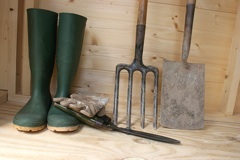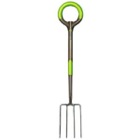Homesteading Supplies
Materials for self sufficiency at home.
Take your Life back!

Homesteading Supplies and equipment needed around the homestead. Basic supplies needed to turn your home into a self sufficient and green homestead.
Homesteading is as individual as the homesteader and while one neighbor may have a raised bed garden, rainwater barrel and composter, another will be cultivating a few fruit trees, 3 laying hens and a container garden.
A backyard farm in the city or suburbs may only need a handful of garden tools and some roomy containers. On the other hand, many acreages have room to house goats, llamas, even a family cow.
The supplies you need will depend, of course, on which aspects of homesteading you've adopted.
Backyard farming tasks require an assortment of simple and relatively inexpensive tools. Often, items you already have around the yard can be put to a new use around the farmyard and you may find that you already have a number of our recommended items. Others can be picked up or repurposed for free. Farm auctions are my favorite place to pick up handy gardening, building and homesteading supplies for around the homestead.
Check out our list of supplies for all aspects of the backyard farm. We'll link you to some of our favorite products and supplies that homesteaders rave about.
Homesteading Supplies for the Garden
- Garden Spade - Everyone has their favorite design. I like the D handle but the long handle gives me better leverage when I encounter a rock or stubborn root.
For serious digging and prying jobs the Fiskars Long Handle Digging Shovel
has a lifetime guarantee that it can handle anything.
- Hoe - It's amazing how many design differences you can find in hoes. Used for weeding, furrowing and cultivating, you may need more than one hoe in your
collection to get all of your chores done. For weeding, our favorite tool is the
Flexrake 1000L Hula Ho
. For breaking up clumps and furrowing the Fiskars Garden Hoe
has a good reputation among users.
- Rake - There are two types of rake intended for different applications.
The leaf rake is a lightweight rake with tines that splay out into a fan shape. Great for raking the lawn, raking leaves and other fluffy, light materials.
The bow rake has short heavy metal tines suitable for leveling soil, sifting rocks and debris out of garden soil and evenly spreading heavy loose materials (like gravel).
The most beloved rake on Amazon right now is the Corona Clipper Steel Head Shrub Rakewhich combines light weight with heavy duty to produce this clean up rake that spans a full 19 inches and isn't afraid of some hard work.
- Pitchfork -
Like rakes, pitchforks come in 2 different weights. Lightweight forks with thin tines (often curved) are used for barn and pen cleaning and easily lift and spread bedding around. A digging fork has heavier and straighter tines. A fork with flair, the funky Natural Radius Grip PRO Digging Fork

has a good reputation among gardeners. Designers managed to add style without subtracting anything from its functionality.
- Weeder - Most of the time our weeder is the good old thumb against forefinger or the hula hoe which is our favorite weeding hoe. For stubborn weeds that
somehow got overlooked in the easy-to-remove stage, Grandpa's Weeder
gets the job done. This, hard to improve on, weeder is soon (2013) to celebrate its 100th birthday.
- Containers - For gardening on the deck, patio or stairway you'll need containers that hold soil and drain well. The choices for containers are endless. Don't run out to the store before you've had a good look around for suitable containers. Use your imagination; old wheelbarrows, bathroom fixtures, pot bellied stoves, galvanized tubs or turn some old lumber into a raised bed garden.
- Pruners - Look for pruners that are lightweight and sturdily built. The Felco Classic Manual Hand Pruner F-2
is a super efficient pruner for taming sturdy shrubs and vines. Repair and maintenance are simple which keeps this tool functional (and out of the landfill) for many years. If your hand is smaller try the small but mighty Felco F-6 Classic Pruner For Smaller Hands
for a comfortable fit.
- String & Stakes - A variety of supplies like netting and chicken wire, bamboo poles and tomato cages, string and stakes and plant markers, will be required from time to time to protect or stabilize your garden plants.
- Greenhouse - Adding a small greenhouse extends the growing season of tender vegetables and offers a secure space for young seedlings to take hold.
Homesteading Supplies - Around the Yard
- Gloves & Gumboots - Garden garb has remained pretty much the same over the years. A pair of gumboots, some garden clogs and a few pairs of garden gloves and you're accessorized. I find that I like lined palms in gloves for cleaning up thorny branches (raspberry canes, blackberry brambles) and a few pairs of unlined washable cotton gloves that can be changed when wet or muddy.
- Composter - Home composting your clippings, cuttings and kitchen scraps closes the loop and begins the mini eco system that a homestead yard becomes. It's easy to make your own with chicken wire, scrap lumber, old pallets, wood lattice, the sky's the limit. On the market the
- Buckets - 5 gallon pails and costco laundry soap containers will be indispensible. We put all of our hand tools in one and turn another upside down to rest on. Hauling water, manure tea, soil and ammendments, carrying in the days vegetables and carrying out the compost, we use buckets constantly throughout the day.
- Wheelbarrow - The workhorse of the homestead is the wheelbarrow. If you want to move this... over there, a wheelbarrow is up for the challenge. For tiny homesteads there are folding wheelbarrows that can be stored in limited spaces but unfold into a handy workmate. Otherwise, choose a sturdy wheelbarrow; you'll expect a lot from it... and it'll deliver.
- Storage Shed - The storage shed keeps things tidy around the yard and provides a secure and dry area in which to store bags of feed, pots, buckets and garden tools. Your storage needs can be met with one relatively large building or any number of small sheds dedicated to specific needs and situated in convenient areas. Once you invite gardens and critters into your life there'll be a need for storage to keep buckets, tools, pots, feed and seasonal homesteading supplies out of the elements and easy to access.
- Rain Barrel - Add a system for harvesting rainwater from your house and outbuildings. Although the recycled whiskey barrels have a lot of appeal there are some very accomodating designs of rain barrels available. Wall huggers and collapsible models take up less area for the space challenged. We used an old horse watering trough and covered it with a sheet of aluminum siding.
- Watering Essentials - An assortment of hoses, nozzles, sprinklers and watering cans to put the water where you want it.
Homesteading Supplies - Harvest & Processing
- Canning Supplies - Canner, jars, lifters, seals and rings, funnels and some sizeable pots and you have all the essentials needed to preserve fruits, vegetables, jams, syrups, salsas, chutneys, meat, fish, and an amazing array of home grown and home processed foods for the winter.
- Food Dryer - Dehydrating food removes most of the moisture and bulk from the food. Maintaining all of the foods nutrients, dehydrators are relatively inexpensive and solar dehydrators require no (or very little) electricity making them a green option for food preservation. Dehydrated foods are lightweight and require much less space to store than canning, root cellaring or freezing.
- Freezer Containers - Freezing is the least amount of work and the most energy intensive way of preserving food.
- Root Cellar - The no-energy way to bring fresh fruits and vegetables to the table all winter long. Every other method of keeping food will alter the taste and
texture of the food. Flavor and texture are unaffected by cellaring and no energy is required for storing your garden fare. For tons of information on making your own root cellar,
which vegetables can be stored and for how long as well as maintaining the perfect environment in your root cellar, check out what Nancy Bubel has to say in
Root Cellaring: Natural Cold Storage of Fruits & Vegetables
.
Homesteading Supplies - Chickens
- At Least 10 sq feet of area per bird. - You may have heard otherwise, but for happy chickens, and happy chicken owners, the more area the better.
- Hen House
- Waterers
- Feeders
- Feed
- Bedding Materials
Homesteading Supplies - Rabbits
- Rabbit Pen
- Waterers
- Food
- Bedding
You don't need a lot of land, expensive farming equipment, or a degree in agricultural sciences. With an open mind, a good sense of humor (especially in the beginning as you are learning), and a few basic homesteading supplies, you can be well on your way to becoming a homesteader.
The internet offers the homesteader a wealth of information on everything from organic gardening tips to installing a solar water heater. At the click of a button you can find out what's ailing your chickens or prepare for the upcoming birth of a new goat. Resources that our forefathers never even dreamed of.
Visitors to our Homesteading Supplies page may also be interested in the following pages.
What is HomesteadingUrban Homesteading
How to Homestead





